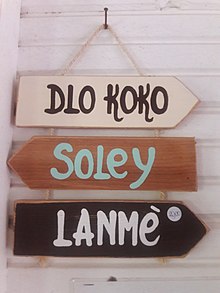
Back Criollu antillanu AST Antilská kreolština Czech Antillen-Kreolisch German Criollo antillano Spanish Créole antillais French Crioulo antillano Galician Անթիլյան ֆրանս-կրեոլական լեզու Armenian Kreol Antilles ID Lingua creola delle Antille Italian Język antylski Polish
This article should specify the language of its non-English content, using {{lang}}, {{transliteration}} for transliterated languages, and {{IPA}} for phonetic transcriptions, with an appropriate ISO 639 code. Wikipedia's multilingual support templates may also be used. (August 2020) |
| Antillean Creole | |
|---|---|
| kreyòl, kréyòl, kréyol, kwéyòl, patwa | |
| Native to | French Antilles (esp. Guadeloupe, Martinique), Dominica, Grenada, Saint Lucia, Haiti, Trinidad and Tobago[1] |
Native speakers | (13 million cited 1998–2001)[2] |
| |
| Language codes | |
| ISO 639-3 | Variously:gcf – Guadeloupean Creoleacf – Dominican Creole / Martinican / Saint Lucianscf – San Miguel Creole French (Panama) |
| Glottolog | less1242 |
| Linguasphere | 51-AAC-cc (varieties: 51-AAC-cca to -cck) |
| IETF | cpf-029 |

Dlo Koko ("coconut water", from French de l'eau de coco)
Soley ("Sun", from soleil)
Lanmè ("the sea", from la mer)
Antillean Creole (also known as Lesser Antillean Creole) is a French-based creole that is primarily spoken in the Lesser Antilles. Its grammar and vocabulary include elements of French, Carib, English, and African languages.[3]
- ^ Ethnologue codes Guadeloupean Creole French (spoken in Guadeloupe and Martinique) and Saint Lucian Creole French (spoken in Dominica and Saint Lucia) distinctly, with the respective ISO 639-3 codes: gcf and acf. However, it notes that their rate of comprehension is 90%, which would qualify them as dialects of a single language.
- ^ Guadeloupean Creole at Ethnologue (18th ed., 2015) (subscription required)
Dominican Creole / Martinican / Saint Lucian at Ethnologue (18th ed., 2015) (subscription required)
San Miguel Creole French (Panama) at Ethnologue (18th ed., 2015) (subscription required) - ^ Erland., Gadelii, Karl (1997). Lesser Antillean french creole and universal grammar. Department of linguistics. ISBN 91-628-2793-6. OCLC 470438107.
{{cite book}}: CS1 maint: multiple names: authors list (link)